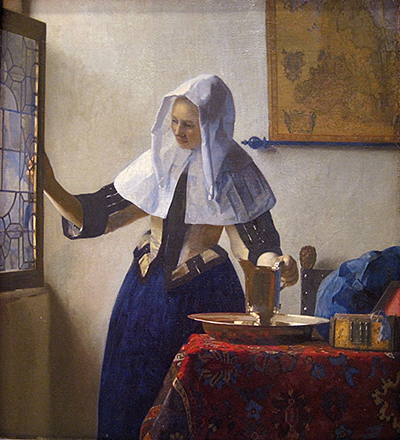The exceptional artwork showcases the mastery of artist Johannes Vermeer as he showcases an array of detail through the artwork the Woman with a Water Jug.
The classic art piece balances transcending colour with elaborate structures manifesting the upper class society at the time in the Netherlands.
The oil on canvas painting dates back to the 1660-1662, falling under the Baroque style. The use of exaggerated art forms and colour is used to manifest the tension and drama within the artwork.
The central figure within the painting is seized by a woman standing with a water jug as she opens the window. The woman is dressed in a dark blue dress with a white top section that flares out onto her shoulders.
The woman is dressed in a white cloak that covers her head and shoulders, a common look that many of the women within Vermeer's paintings wore. The artist continues with the classic element of placing a window at the right side of the canvas, this mosaic piece illuminates a light glow onto the woman, as her face is highlight by the light.
The water jug is a silver colour that is placed on another large silver base upon the table. The artist had reused a red blanket upon the table the over the surface, a common fabric that has been seen in Vermeer's other work, The Music Lesson. It is well known that the artist favoured reusing bright fabrics and colours throughout his home to aid in the scenery. The table is covered in the red table cloth adding texture and drama to the calm artwork.
The woman within the portrait seems to be posing as the artist depicts her details onto the canvas. The woman within much of the artist's work is believed to be his wife who often posed for him. Vermeer is mostly known for his depiction of woman within art as evident through the painting. Their graceful manner allows a warmer feel to up rise through the work welcoming the viewer.
Near the background of the painting is a large map placed against the wall showcasing the regions of the Netherlands. With no formal education, the brilliant artwork is difficult to believe that it was conceived at the onset of the artist's career. The artwork is believed to be one of the artist's transitional paintings as he found his own style and genre.
Vermeer had begun his career depicting biblical paintings that showcased stories of Christ and those from the New Testament. Religious depictions have been common in art since the Early Renaissance, with significant artworks being The Last Supper by Leonardo da Vinci, Creation of Adam by Michelangelo and Return of the Prodigal Son by Rembrandt.
The painting is based on a linear format that uses geometric patterns to illustrate the muse being painted. The artist is believed to have used a camera obscure in order to aid in his production of art in order to have a better view of his work.
Using a camera allowed for the artist to be able to view his work in a better form. Vermeer had based his work on linear styles at the onset of his career, before he transitioned towards 3D imagery.
The masterful artwork is a prominent piece by the artist, intertwining soft brush strokes with cool colours adding to the texture of the work.




